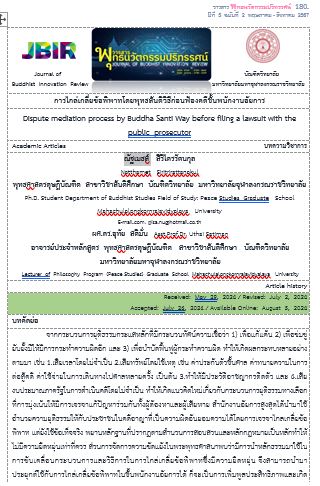DISPUTE MEDIATION PROCESS USING BUDDHIST SANTIMETHOD: SPECIFIC CASE STUDY THE PROSECUTOR'S OFFICE PROTECT RIGHT AND PROVIDE LEGAL ASSISTANCE AND LEGAL ENFORCEMENT IN CHIANG MAI PROVINCE
Main Article Content
Abstract
From the mainstream justice process that has a belief paradigm: 1) to take revenge, 2) to intimidate and prevent another offense from being committed, and 3) to rehabilitate the offender. This causes many consequences, such as: 1. Waste of time unnecessarily. 2. Loss of property due to reasons such as court bail costs. Attorney's fees for fighting the case Expenses for traveling to court many times, etc. 3. Causes a criminal record and 4. Loss Government budget for unnecessary litigation This creates a new idea about the alternative justice process that focuses on negotiating and solving problems together for both the accused and the victim. The Attorney General's Office has used it to provide justice to people in criminal cases that are compromisable through negotiation and mediation. But also use facts The evidence that appears in the investigation file and legal principles is the main cause.Not as flexible as it should be As for conflict management in Buddhism, it was found that Dhamma principles are used to drive the process and methods for mediating disputes, which are flexible. Therefore, it can be applied to mediating disputes at the prosecutor level. It will increase efficiency and bring even more benefits. It was found that the principles that are consistent with mediating disputes before filing cases at the public prosecutor level include:The 4 Brahmavihāra Dhammas and the 4 Sangha Vatthu Dhammas, applied with the "4 Noble Truths (RCGP)+The Noble Eightfold Path", can be defined as mediating disputes using the Buddhist Santi Method, namely 1) the planning step with the Noble Eightfold Path. 4 (RCGP) including 1. R = Result, determine what the problem is caused by, 2. C = Cause, determine what the cause of the problem is, 3. G = Goal, determine what the desired goal is, and 4. P = Process, determine Methods for arranging what it should be like: 2) The process of mediating disputes by using the method of the Noble Truths to be organized into the Threefold Disciple: 1. Adhi precepts, including right speech, right action. and right livelihood 2. Adhicitta-sikkha includes right vayama, right mindfulness and right concentration. 3. Adhipaññāsikkha, including right view and right mindfulness.
Article Details

This work is licensed under a Creative Commons Attribution-NonCommercial-NoDerivatives 4.0 International License.
เรื่องลิขสิทธิ์/เป็นความคิดเห็นของผู้เขียน
References
Books:
Mahachulalongkornrajavidyalaya University.Pali Tripitaka Mahachula Thepitakam edition 1992. Bangkok: Mahachulalongkornrajavidyalaya Printing House.
Office of the Attorney General. (2012). Guidelines for mediation and conciliation of criminal cases at the public prosecutor level,2012. Bangkok: Office of the Prosecutor for the Protection of Rights and Legal Assistance for the People (NCPO).
Phra Brahma Kunaporn (Prayut Payutto).(2008). Dictionary of Buddhist Science 17th printing edition. Bangkok: Mahachulalongkornrajavidyalaya University.
Phra Mahahansa Dhammahaso (Nitibunyakorn). (2018). Buddhist Santiwitthi Integrating conflict management principles and tools. 2nd printing. Bangkok : Prayurasas Thai Printing Ltd.
Jutharat Uayana, (2007).“Restorative Justice Process: “Options” for Ending Conflicts Criminal Justice for Thai Society”, Restorative Justice Process. 1st printing, Bangkok: Printing House, Agricultural Cooperatives Association of Thailand Company Limited.
Kittipong Kittayarak and Jutharat Amueya, (2007).“Future Justice System and Peace in society and community”, restorative justice process. 1st printing, Bangkok : Chamchum Printing House Agricultural Cooperative of Thailand Company Limited.
Journal:
Ratthaphon Yenchaima,Suraphon Suyaprom. (April-June). Prasit Buddhist faith. Conflict in society: Theoriesand solutions. Journal of Social Science Review. 2018. 7 (1); 224-226. (in Thai)
Ploenta Tanrangsan. (May-June). Restorative Justice Process with the delinquency of children and youth, Chulniti Journal. 2010. 4 (3); 54-58. (in Thai)
Electronics:
Phra Phaisan Visalo. Buddhist mediation. [Search on 10 January 2024]. [Online], Retrieved from : www.visalo.org.
Office of the Attorney General. [Search on 10 January 2024] [online], Retrieved from; www.ago.go.th
Criminal Code. [Search on 10 January 2024]. [online], Retrieved from; www.ocs.go.th
Restorative Justice Process, [Search on 18 January 2024]. [online], Retrieved from; www.senat.go.th


